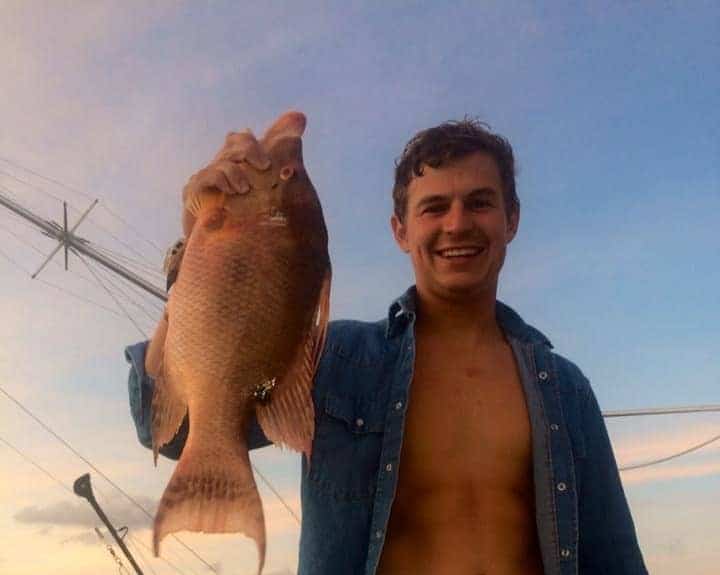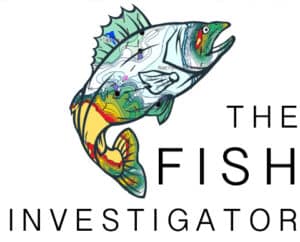
Until recent years anglers had no idea how to catch Hogfish and resorted to spearing them on shallow-water reefs. However, the times have changed. Let’s take a look at how to catch these interesting bottom feeders using hook and line.
How To Catch Hogfish
Hogfish are caught fishing nearshore reefs in 25′ to 75′ of water using live shrimp on light tackle. Hogfish prefer natural reefs with ledges, cracks, and the occasional pocket of sand. Hogfish are bottom feeders, so your bait must remain on the bottom to have success catching them.
Finding Your Hogfish Hotspot
When it comes to catching Hogfish, the first thing to do is find a fishing spot conducive to Hogfish. One of the best ways to find your Hogfish hotspot is to do your research and find a nearshore natural reef that is known to have cracks, ledges, and surrounding pockets of sand. The best depth for targeting Hogfish ranges from 25′ to 75′, with 50′ of water being the sweet spot. Hogfish are bottom dwellers, so finding the ideal bottom structures is essential in catching Hogsnapper.
When you have located your fishing grounds, it is important that you anchor your boat right at the edge of the reef you are targeting. Hogfish are known to congregate heaviest in areas where the natural reefs meet ledges and sandy bottom.
Use “Hogsnapper,” Chum
Once you are anchored up out at your Hogfish fishing grounds, it’s time to get a block of chum in the water. Instead of using a typical block of chum, use a shrimp and shellfish-based chum. Also when chumming for Hogfish, it’s best to sink your block of chum to the bottom using a weighted chum bucket. Getting the chum to the bottom is critical in attracting large Hogfish.
Getting Lines in the water
So now you are anchored up out at your fishing grounds, and you have chummed up the water; it’s time to catch some fish.
I have always had the best success fishing light tackle when targeting Hogfish. It seems a 30lb braid with a 30lb fluorocarbon leader is ideal, giving you enough strength to bring the larger fish off the bottom while not being too big that it spooks the fish from taking your bait.
Regarding fishing rigs, I recommend using a knocker rig which is simply an egg sinker that slides up and down the leader line. Since Hogfish fishing is done in around 50’of water, a 1 to 2-ounce egg sinker is ideal.
Choosing the right bait for Hogfish
When it comes to catching Hogfish, using medium to large live shrimp is ideal. Some people have had success fishing sand fleas for Hogfish, but nothing outfishes a good old shrimp.
Expert Tips On Catching Hogfish
- Bring more shrimp than you think you will need: I have learned that when fishing for Hogfish, 70% of your strikes will be other types of fish. Fish like Porgies and Grunt are infamous for stealing your bait the moment you hit bottom. Because of this, I recommend bringing two dozen shrimp per angler per hour. So say you are fishing with three anglers for three hours, you will want to bring at least 16 dozen shrimp. This may sound crazy if you have never targeted Hogfish, but I promise you, you won’t regret it.
- Find the Sea Fans: I learned this tip from years and years of targeting Hogfish using a spear. Hogfish absolutely love congregating around large Sea Fans. If you can mark on your depth finder or visually locate a series of sea fans on the bottom, you can be confident in knowing you are in Hogfish territory.
- Choose the right month: Getting out on the water at the right time of year is absolutely key when targeting Hogfish. Hogfish are most abundant on nearshore reefs from November through March.
- Clear, healthy water is key: Hogfish are known to congregate in areas with high water quality. As water conditions decline, Hogfish move into deeper waters that are more abundant with nutrients and dissolved oxygen. The inverse is true, so when water quality is high, Hogfish can be caught in shallower waters.
- The perfect retrieval: Hogfish are bottom feeders, so it is essential that your bait is on or close to the bottom when you target them. One technique that has proven quite successful over the years is slowly dragging a live shrimp along the bottom. It is believed that the commotion your sinker and bait make on the bottom sparks the interest of nearby Hogfish, and once they investigate it, they cannot resist the free meal.
- Porgy & Grunt are a good sign: You will know you are in Hogfish territory if you are constantly hooking up to Porgy and Grunt. Often it will take a process of catching a dozen or so Porgies and Grunt before you start getting into the Hogfish. If after you’ve caught over two dozen porgies and grunt, you may be too centrally located on top of the reef, and you may want to relocate, so you are fishing the outskirts of the reef instead.
- Bring the correct chum: I mentioned this earlier, but this can not be said enough, bringing the correct chum can make or break your day when targeting Hogfish. Unlike many reef-dwelling fish, Hogfish do not prey upon whitebait but only consume shrimp and other shellfish. Knowing this, you will want to use a chum that matches their diet. There are a couple of brands that make quality chum, including “Snapper Up,” which is a dried chum mix that can be stored without refrigeration.
When Can You Catch Hogfish?
Hogfish are caught year-round, with late fall and winter being the most productive time to catch them. As water temperatures drop, Hogfish move into shallow water to spawn, resulting in aggressive eating behavior, which often equates to more landed fish.
Where Do You Catch Hogfish?
Hogfish are caught in tropical, subtropical, and temperate waters ranging from 25′ to 75′ in depth. Hogfish congregate heavily on natural reefs, especially reefs with ledges where Hogfish can forage for food. Hogfish are known to prefer reefs that are adjacent to hard sandy bottoms.
Best Fishing Spots for Hogfish
- Natural reefs
- Ledges
- Seafans
- Sandy bottom
Best Fishing Tackle For Catching Hogfish
When it comes to catching Hogsnapper, you can significantly increase your overall success by choosing the correct tackle.
Best Fishing Rod For Hogfish
When choosing the best fishing rod for Hogsnapper, you will want to choose a rod that has a medium weight and fast action. I have always loved Star Rods for their strength, sensitivity, and warranty.
Best Fishing Reel For Hogfish
The best reel size for targeting Hogsnapper is going to be a 3000- 4000 size reel. Hogfish are good fighters initially but quickly run out of stamina as they are retrieved back to the boat. I have always loved the Penns Battle series for fishing adventures like this. Battles are great reels that will last, and their price tag is far below its value.
Best Line To Use For Hogfish
When targeting Hogfish, the best line to use is a 30lb braid. Since Hogfish is a bottom-dwelling fish, it is essential that the moment they are hooked, you get them off the bottom before they can run you into bottom structures. Because braid has little to no stretch, you can get Hogfish off the bottom quickly, dramatically decreasing your chances of getting caught up on the reef.
What Size Leader To Use For Hogfish?
The best size leader for catching Hogfish is a 30lb test. Hogfish are slightly sensitive to heavy tackle, so it is best to keep things as light as possible. I always recommend using a quality fluorocarbon leader cut at a length of 36 inches.
What Size Hooks For Hogfish?
The best hook size for targeting Hogfish is a 1/0 circle hook. Even though Hogfish have large mouths, they prefer baits that are presented on smaller hooks. Smaller hooks allow your bait, which is typically live shrimp, to swim naturally along the bottom.
Let’s take a deeper look at how to catch Hogfish by learning more about the species as a whole.
What are Hogfish?
Lachnolaimus maximus, commonly referred to as Hogfish, Hog Snapper, or Hogs, is a shallow-water reef fish that inhabits tropical, subtropical, and temperate waters. Hogfish are most abundant in tropical waters, with the Florida Keys and Bahamas being abundant fisheries to target them. Hogfish, AKA Hog Snapper, is not a snapper at all but rather a Wrasse.
Hogfish bodies are laterally compressed, often sporting tropical colors, including reds, yellows, oranges, and pinks. Hogfish’s first three dorsal spines are a long string-like structure that stretches over a 3rd of the fish’s overall size.
Hogfish mainly acquired their common name from how they hunt for food. Hogfish often take their hog-like snout and poke it into the sand and other substrates in search of a meal in roughly the same manner as land-dwelling hogs forage for food.
Natural Hogfish Diet
- Mollusk
- Crabs
- Sea Urchins
- Shrimp
- Echinoderms
Are Hogfish Good To Eat?
Hogfish are excellent to eat. Hogfish meat is white, flaky with a mild flavor profile making for phenomenal table fare. The mildly sweet flavor of Hogfish has made them a staple at many seafood restaurants.
Is Hogfish Toxic?
Hogfish are known to carry the Ciguatera toxin, which is common amongst reef-dwelling fish. Larger Hogfish are more likely to have higher levels of Ciguatera, which can lead to food-borne illness in humans. Ciguatera poisoning can cause various symptoms including diarrhea, vomiting, and dizziness.
Are Hogfish In The Snapper Family?
Hogfish are not in the Snapper family, contrary to the name Hog Snapper that they have typically been referred to as. Hogfish are actually a Wrasse, whereas Snapper is in the Lutjanidae family.
Do Hogfish Have Scales?
Hogfish have colorful scales that start from their gill plates and end at the base of their tales.
Do Hogfish Have Teeth?
Hogfish have four large canine-like teeth located on their top jaw and two on their bottom jaw. Behind Hogfish’s canine teeth, you will also find a single row of canonical teeth that are small and razor-sharp.
Hogfish Size & Bag Limit
| State | Size | Bag Limit |
| Florida | 14″ Minimum | 5 |
| Georgia | 17″ Minimum | 2 |
| South Carolina | 17″ Minimum | 2 |
| North Carolina | 17″ Minimum | 2 |
| Texas | 14″ Minimum | 5 |
